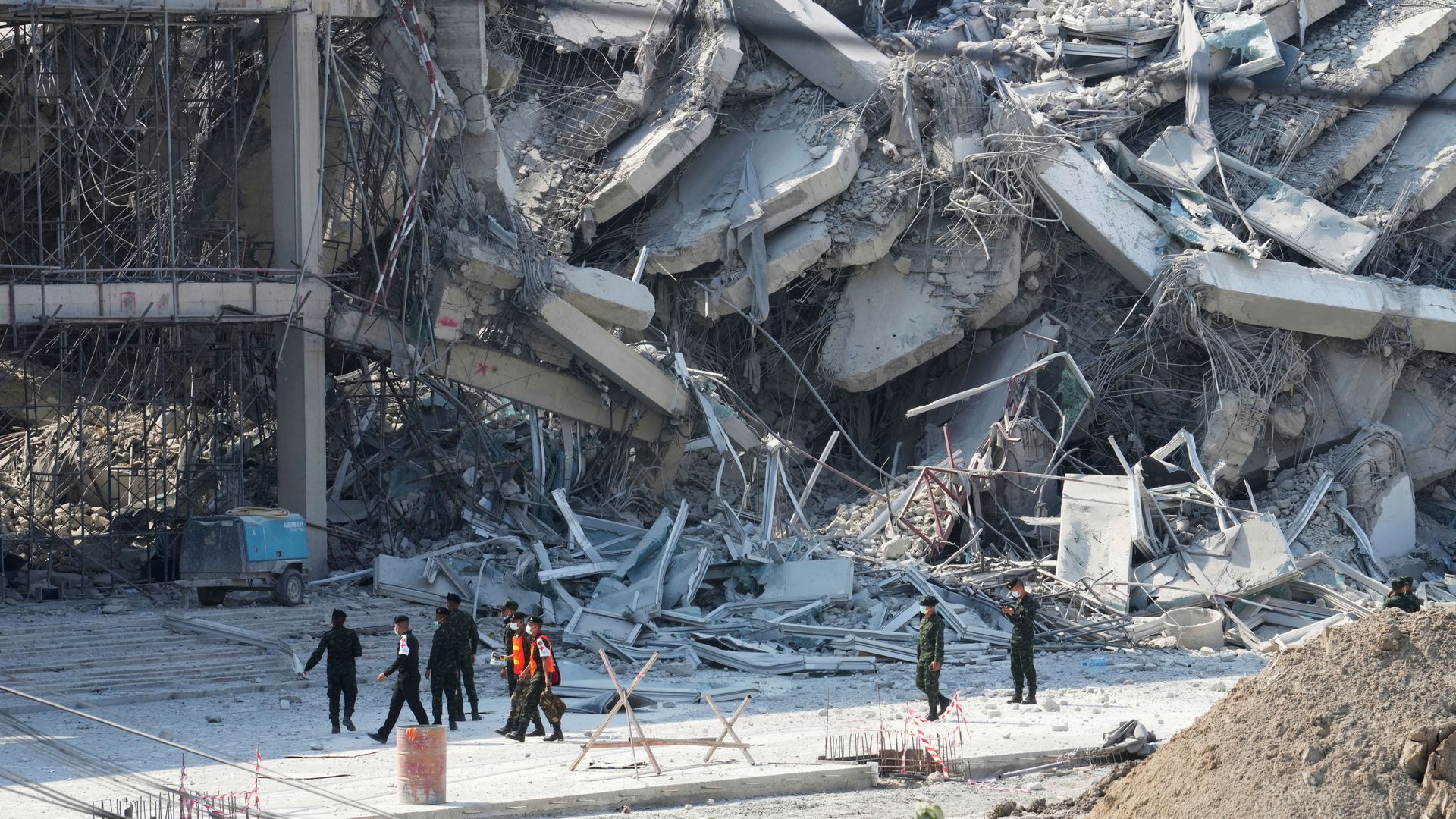At least 144 people have been killed and 730 others injured in Myanmar following a powerful earthquake, according to the head of the country’s military government.
“The death toll and injuries are expected to rise,” Senior General Min Aung Hlaing said on television.
The 7.7 magnitude quake struck around midday local time at a shallow depth of six miles, with the epicentre about 10 miles from the second city of Mandalay. There were also aftershocks, with one measuring a strong 6.4 magnitude 12 minutes later.
Neighbouring Thailand was also rocked by the earthquake, with nine people killed in the capital Bangkok, including eight who died after a skyscraper, which had been under construction, collapsed.
Follow live: Myanmar earthquake latest
Rescuers searching through the rubble of the tower block for survivors have said more than 100 people were missing.
Footage showed the high-rise in the Chatuchak area crashing to the ground as people ran away from the scene.
Please use Chrome browser for a more accessible video player
In Myanmar, buildings in five cities and towns collapsed, along with a railway bridge and a road bridge on the Yangon-Mandalay Expressway, state media reported.
Images showed the destroyed Ava Bridge over the Irrawaddy River, with its arches leaning into the water.
A rescue worker from the Moe Saydanar charity group said it had retrieved at least 60 bodies from monasteries and buildings in Pyinmanar, near the capital Naypyidaw, and more people were trapped.
‘Building collapsed in front of my eyes’
“We all ran out of the house as everything started shaking,” a Mandalay resident said.
“I witnessed a five-storey building collapse in front of my eyes. Everyone in my town is out on the road and no one dares to go back inside buildings.”
Another Mandalay resident said destruction stretched across the whole city, and one neighbourhood, Sein Pan, was on fire.
Roads were damaged, phone lines disrupted and there was no electricity, they said.
Other eyewitnesses said three people died while praying when a mosque partially collapsed in the Bago Region. Images have also emerged of a destroyed temple in Naypyidaw.
Meanwhile, local media has reported that at least two people died and 20 were injured after a hotel collapsed in Aung Ben.
Civil war in Myanmar
The natural disaster comes as the country is in the grip of a civil war.
The ruling military junta said a state of emergency has been declared in Sagaing Region, Mandalay Region, Magway Region and northeastern Shan State, Nay Pyi Taw Council Area, and Bago Region.
The junta added in a statement: “The government has ordered a rapid investigation of the damage in these areas, We will carry out relief and relief operations promptly. We will also work to provide necessary disaster relief and humanitarian assistance.”
Read more:
Eyewitnesses describe earthquake hitting Myanmar and Bangkok
By Cordelia Lynch, Asia correspondent in Bangkok
I was in the office in Bangkok at around 1:30pm when I felt the tremors.
Lights start to swing, the windowpanes shook and people rushed downstairs to evacuate the building.
The prime minister has established a “war room”- a very rare move, to help respond to the impact of the tremors.
The damage in Myanmar appears far worse though.
And this in a country ravaged by civil war.
Getting information from there is very challenging. Getting aid into affected areas will be too.
The Red Cross has said downed power lines are adding to challenges for their teams trying to reach Mandalay and Sagaing regions and southern Shan state.
Science and technology editor
The world’s highest mountain range – the Himalayas – is testament to the power of plate tectonics.
Forced upwards by the gradual northward push of the Indian plate into the Eurasian plate.
It’s a power that’s almost impossible to imagine until just a tiny fraction of it is suddenly released.
And that’s what happened just six miles beneath the feet of 1.2 million people living in the city Mandalay and surrounding settlements.
A fault line along that Indian-Eurasian plate boundary runs almost directly beneath the city.
Over decades, as the plates grind past each other, tension builds up in the subsurface rock. When it finally gives, an earthquake is the result.
Such strike-slip faults as they’re known don’t generate the world’s most powerful earthquakes. That dubious honour goes to subduction zones in places like Sumatra and Japan that generate the magnitude 9 earthquakes that caused the Boxing Day tsunami of 2004 or the Tohoku tsunami of 2011.
A magnitude 7.7 quake is still extremely powerful and destructive if it occurs shallow in the Earth’s crust and close to population centres. This did both.
Recent history has an important role to play too. Large earthquakes in this region happen every decade or so. But the last one of this size in the Sagaing region was in 1946.
That pre-dates the development of modern earthquake building codes. Reconstruction in Mandalay and beyond after that event will have resulted in buildings vulnerable to collapse from shaking of this magnitude and possibly already weakened by previous events.
Meanwhile, hundreds of people poured out of buildings in Bangkok after the tremors, with many buildings evacuated.
The city is home to 17 million people and many live in high-rise apartments.
Follow our channel and never miss an update.
Alarms went off in buildings as the earthquake hit around 1.30pm local time (6.30am UK time).
Footage on social media has shown water being thrown down the side of buildings from rooftop swimming pools.
All flights in and out of Bangkok are operating normally following the earthquake, the country’s civil aviation department said on Friday.









